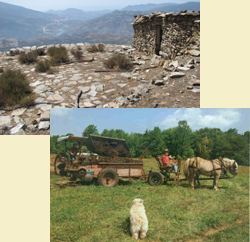Agriculture, Northland Sheep Dairy
Cities and Suburbs in the Energy Descent: Thinking in Scenarios
Monday, October 8th, 2012This article was originally reviewed, edited and published by Tompkins County Relocalization, a group in upstate New York that is researching various aspects of energy descent.
“A city could be defined, almost, as a human ecosystem that grossly exceeds the carrying capacity of its local environment.” – William Catton
The vulnerability of cities and suburbs in [...]
Reductionist Science and the Rise of Capitalism: Implications for a New Educational Program of Agricultural Science
Wednesday, January 4th, 2012The thesis of this essay is that there is a way of doing science that is characteristic of scientific inquiry under capitalism because its methods provide the kind of “irresponsible knowledge” that a profit-at-whatever-cost social system like capitalism requires. As my title implies, I will argue that as capitalism evolved to become an ever more [...]
Implications for Agriculture of Peak Cheap Energy
Sunday, November 27th, 2011By way of introduction to what I have to say, let me explain the evolution of my thinking. As a farmer for 30 years, I have been an active participant in the movement to develop alternatives to Industrial Agriculture. As you may know, much of the motivation for that movement was a growing awareness of [...]
On Invasives
Thursday, November 18th, 2010What I will say here about the issue of invasives may seem picky, but it is not, because it points up a fundamental flaw in how we think about any intervention into the complex, systemic world in which we live.
The flaw running through the whole discourse about invasives is the tendency to see them too [...]
Visioning County Food Production – Part Five
Sunday, October 24th, 2010Part Five: Peri-urban Agriculture
This series of articles is an exploration of designs for agriculture in Tompkins County to approach sustainability in a future of declining access to the cheap energy and other inputs on which our industrialized food system relies. In earlier parts of this series, I proposed principles of agroecosystem design; addressed the [...]
Visioning County Food Production – Part Six
Tuesday, August 10th, 2010Part Six: Rural Agriculture
This series of articles is an exploration of designs for agriculture in Tompkins County to approach sustainability in a future of declining access to the cheap energy and other inputs on which our industrialized food system relies. In earlier parts of this series, I proposed principles of agroecosystem design; addressed the key [...]
Visioning County Food Production – Part Four
Monday, April 19th, 2010Urban Agriculture
This series of articles is an exploration of designs for agriculture in Tompkins County to approach sustainability in a future of declining access to the cheap energy and other inputs on which our industrialized food system relies. In earlier parts of this series, I proposed principles of agroecosystem design, addressed the key [...]
Visioning County Food Production – Part Three
Monday, March 8th, 2010
Seeing County Food Production as an Integrated Whole
In Part One of this series, I proposed principles of agroecosystem design for growers to follow if agriculture is to approach sustainability in a future of declining access to the cheap energy and other inputs on which our industrialized food system relies. I said that providing [...]
Visioning County Food Production – Part Two
Monday, February 15th, 2010General Problem Areas in Sustainable Agricultural Design
In Part One of this series, I noted that providing for the local food needs of urban populations requires a design that integrates three overlapping categories of production systems: urban agriculture systems (many small islands of gardening in the city center), peri-urban agriculture (larger production areas on the immediate [...]
Visioning County Food Production – Part One
Sunday, February 14th, 2010Visioning County Food Production
by Karl North
“Because energies and monies for research, development, and thinking are abundant only during growth and not during energy leveling or decline, there is a great danger that means for developing the steady state will not be ready when they are needed, which may be no more than 5 years away [...]
